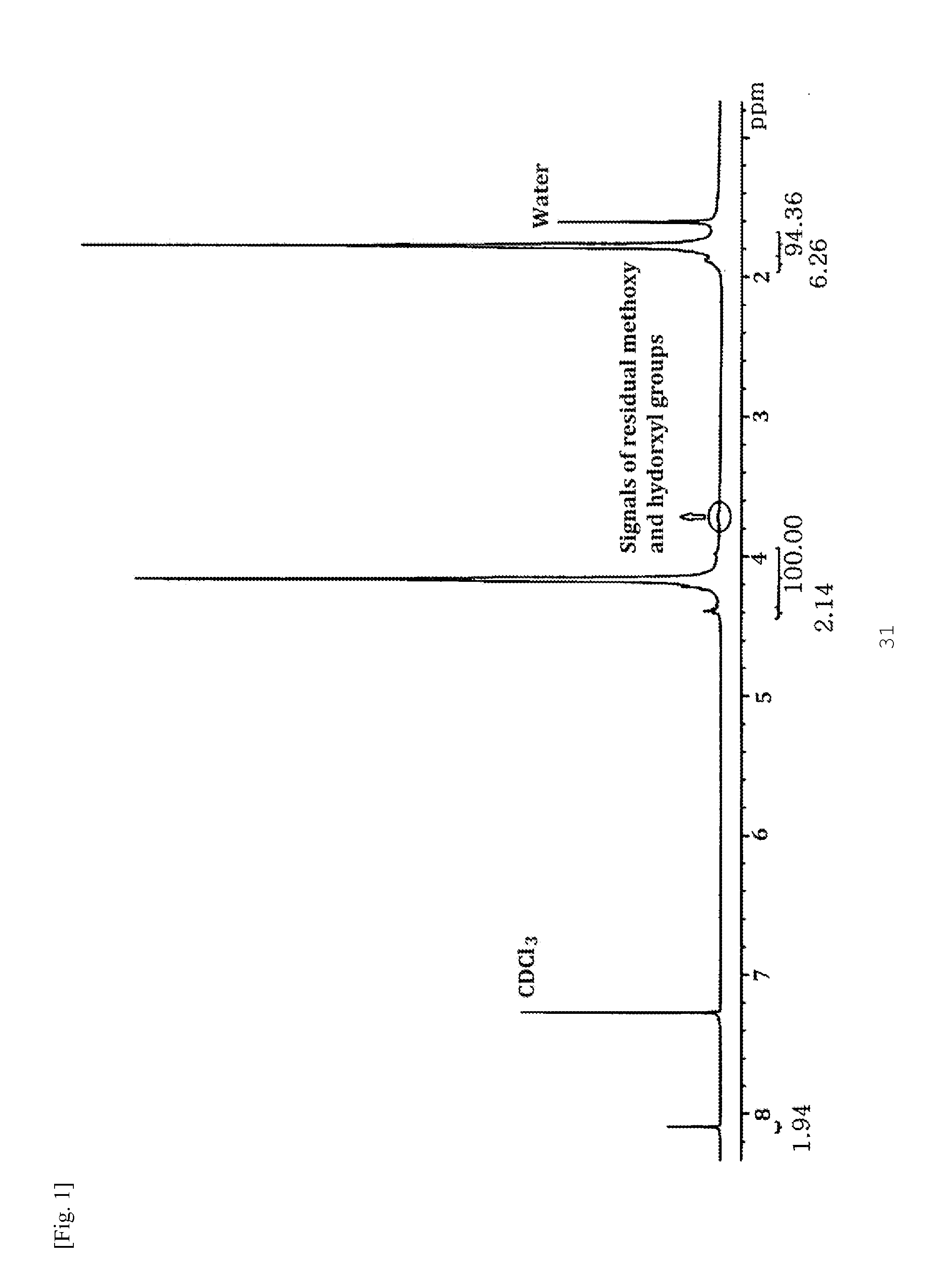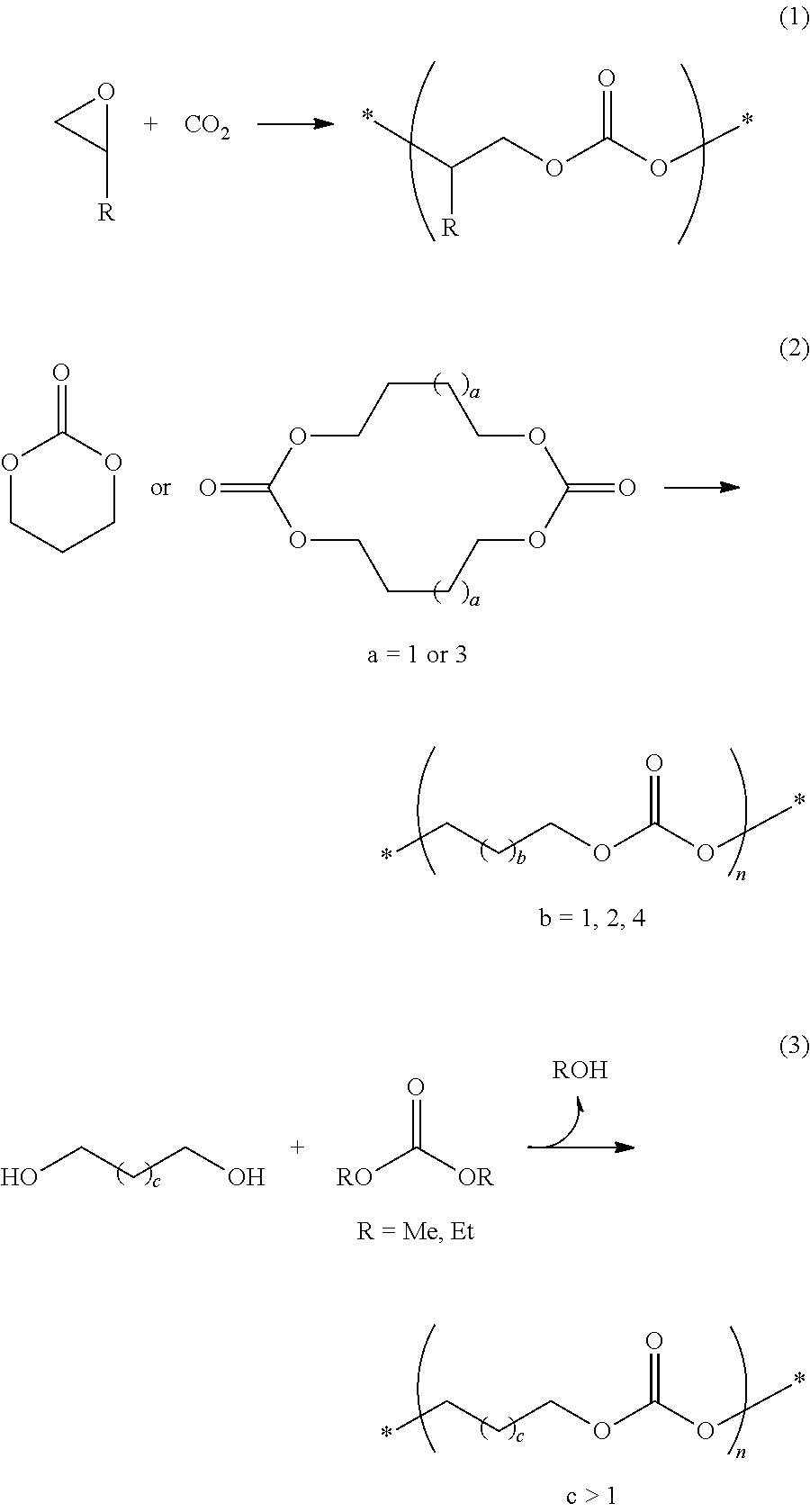High molecular weight aliphatic polycarbonate copolymer and preparation method thereof
a polycarbonate, high molecular weight technology, applied in the field of high molecular weight aliphatic polycarbonate copolymer and a method for preparing the same, can solve the problems of limited physical properties of poly(propylene carbonate), aliphatic polycarbonates, and inability to meet the needs of poly(propylene carbonate), and achieve the effect of higher molecular weigh
- Summary
- Abstract
- Description
- Claims
- Application Information
AI Technical Summary
Benefits of technology
Problems solved by technology
Method used
Image
Examples
examples 1-3
Condensation Reaction of 1,4-butanediol and Dimethyl Carbonate
[0059]A base was added to 1,4-butanediol (10.0 g, 110 mmol) in a 3-neck flask to form HO(CH2)4O−M+, and then dimethyl carbonate (DMC, 15.0 g, 167 mmol) was added thereto. A mechanical stirrer was connected to one neck of the flask, a manifold attached with a vacuum line and a nitrogen line was connected to another neck of the flask, and a distillation unit was connected to the remaining neck of the flask. After the reaction flask was immersed in a thermostatic bath at 120° C., the reaction was carried out for 1 h while distilling off formed methanol and a portion of the DMC at ambient pressure. A slight amount of the reaction mixture was sampled. After removal of methanol and unreacted DMC from the sample at room temperature, the molar ratio between —OH and —OCH3 functional groups was determined by 1H NMR analysis. The reaction was continued for 2 h while removing volatiles at an elevated temperature of 180° C. and a redu...
example 4
Condensation Reaction Between 1,6-hexanediol and Dimethyl Carbonate
[0061]The procedure of Example 1 was repeated except that an equimolar amount of 1,6-hexanediol was added instead of 1,4-butanediol. As a result of 1H NMR analysis, three strong signals with a 1:1:1 intensity ratio were observed at 4.11 ppm, 1.68 ppm, and 1.41 ppm. A peak corresponding to the terminal —CH2OH groups was observed at 3.64 ppm and a very weak peak corresponding to the terminal —OCH3 groups was observed at 3.64 ppm. The results of polymerization are shown in Table 2.
TABLE 2Results of condensation reaction between 1,6-hexanedioland dimethyl carbonate[OCH3] / [OH]Yield (%)Mw × 10−3Mn / Mw1.28951271.81
examples 5-11
Condensation Reactions Between 1,4-butanediol and Dimethyl Carbonate Under Addition of Aromatic Diesters
[0062]The procedure of Example 1 was repeated except that the dimethyl esters derived from the dicarboxylic acids of Formulae 3a to 3d were further added and the amount of DMC added was changed depending on the amounts of the dimethyl esters. DMC was used in amounts of 15.5 g (194 mmol) in Examples 5-6 and 9-11 and 15.0 g (167 mmol) in Examples 7-8. The results of polymerization are shown in Table 3. 1H NMR analysis revealed that the diester groups were introduced into the polymer chains. In each spectrum, two strong signals with a 1:1 intensity ratio were observed at 4.15 ppm and 1.77 ppm, very small signals corresponding to the terminal —CH2OH and —OCH3 groups were observed at 3.68 ppm and 3.77 ppm, respectively, an additional signal corresponding to the diester was observed. When dimethyl terephthalate as the dimethyl ester derived from Formula 3a was further added, a triplet s...
PUM
| Property | Measurement | Unit |
|---|---|---|
| mole fraction | aaaaa | aaaaa |
| temperature | aaaaa | aaaaa |
| molar ratio | aaaaa | aaaaa |
Abstract
Description
Claims
Application Information
 Login to View More
Login to View More - R&D
- Intellectual Property
- Life Sciences
- Materials
- Tech Scout
- Unparalleled Data Quality
- Higher Quality Content
- 60% Fewer Hallucinations
Browse by: Latest US Patents, China's latest patents, Technical Efficacy Thesaurus, Application Domain, Technology Topic, Popular Technical Reports.
© 2025 PatSnap. All rights reserved.Legal|Privacy policy|Modern Slavery Act Transparency Statement|Sitemap|About US| Contact US: help@patsnap.com



